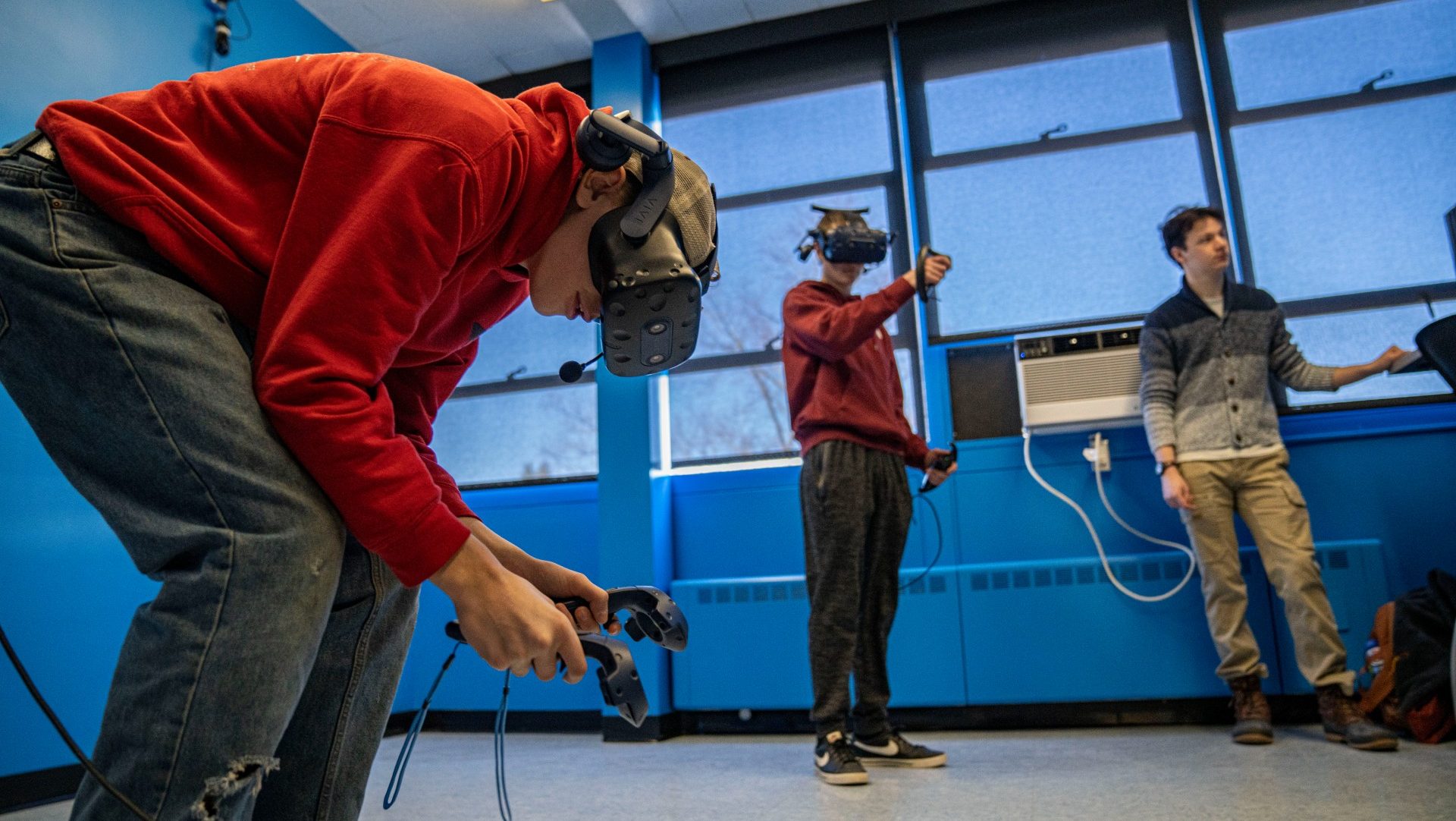
Study describes how K-12 teachers used UMaine-developed virtual environment to explore mathematical concepts
When Old Town High School Math Teacher Kristen Thompson uses TriO — a virtual reality environment developed by researchers at the University of Maine — she envisions a scenario that every teacher dreams about for their students: constant collaboration.
“It builds up to having to work with others,” Thompson said. “You’re having conversations about what levers to move and when.”
TriO allows multiple users to naturally explore directional and spatial reasoning in virtual, three dimensional space, without feeling like they’re doing traditional math.
“It gets users working together to achieve a common goal in a very active and fun way,” said Thompson.
TriO was designed by a team at UMaine’s Immersive Mathematics in Rendered Environments (IMRE) Lab with the goal of offering K-12 teachers and students new ways to delve into familiar mathematical concepts. A new study, published in Digital Experiences in Mathematics Education, describes what happened when six high school teachers used the environment to explore geometry and coordinate systems. These ideas are traditionally taught using analog tools — think paper and pencil or white board and marker — in two dimensions. TriO allows users to learn and explore them in three dimensions.
Matthew Patterson, research associate, lab manager and chief engineer with the IMRE Lab, designed and coded TriO. It’s a three-player version of Ortho, a two-player virtual environment designed and developed by Dor Abrahamson of the Embodied Design Research Lab at the University of California, Berkeley.
“Dor had the initial idea for a three-person iteration of the Ortho environment that would allow users to work collaboratively in three dimensions, and he encouraged us to design and develop it,” said Patterson, who coded TriO using Unity, a cross-platform game engine used to create a variety of 2D and 3D games. Users can experience it with any off-the-shelf VR headset.
In TriO, each player controls one of three virtual handles of a small disc-like object, or widget. The red (x) handle moves the widget left and right, the green (y) moves it up and down, and the blue (z) handle moves it forwards and backwards. By moving together, the immersed players can navigate the widget through virtual space. The goal of the experience is for the participants to develop an experiential feel for how space and their movements through space can be described mathematically.
“We designed it so that players are able to slide the handles along the x, y or z axes with pushing or pulling actions, and the handles can be moved simultaneously, allowing for coordinated action on the widget,” Patterson said.

Justin Dimmel, associate dean for academics and student engagement with UMaine’s College of Education and Human Development, is founder and director of the IMRE Lab. He says the idea behind TriO was to create an environment where teachers and students could explore abstract mathematical thinking, specifically around coordinate systems.
“Think back to middle school, which is typically when students start to learn about mapping Cartesian coordinates on a two-dimensional plane with an x and y axis,” Dimmel said. “When you add a third dimension, it opens the possibilities for understanding coordinates and their relationship to space.”
For the study, Dimmel and Patterson invited six high school teachers to a three-day workshop at the IMRE lab, where they tested TriO and shared their experiences in focus group interviews. During testing, the researchers left it up to the teachers to decide how to use the environment and how to work together within it.
“We view teachers as co-designers of the TriO environment,” said Dimmel. “We’re not imposing a curriculum or telling them this is how you have to use it, because we recognize that the specific ways they and their students engage with the virtual environment can and will change depending on their teaching and learning goals.”
Dimmel says the data collected from the focus groups provided a “proof-of-concept,” illustrating the possibilities of doing mathematical activities while immersed in TriO. For example, one group of teachers who participated in the study were able to work collaboratively to navigate to each of the vertices of a cube along a diagonal path.
Dimmel, Patterson and Abrahamson recently gave a presentation on their collaboration at the Luxembourg Institute for Social and Economic Research’s Experimental and Participatory Research Seminar Series. The study and IMRE Lab were made possible by a National Science Foundation CAREER Award that Dimmel received in 2022 to investigate the possibilities of using virtual and augmented reality in mathematics education.
Contact: Casey Kelly, casey.kelly@maine.edu
